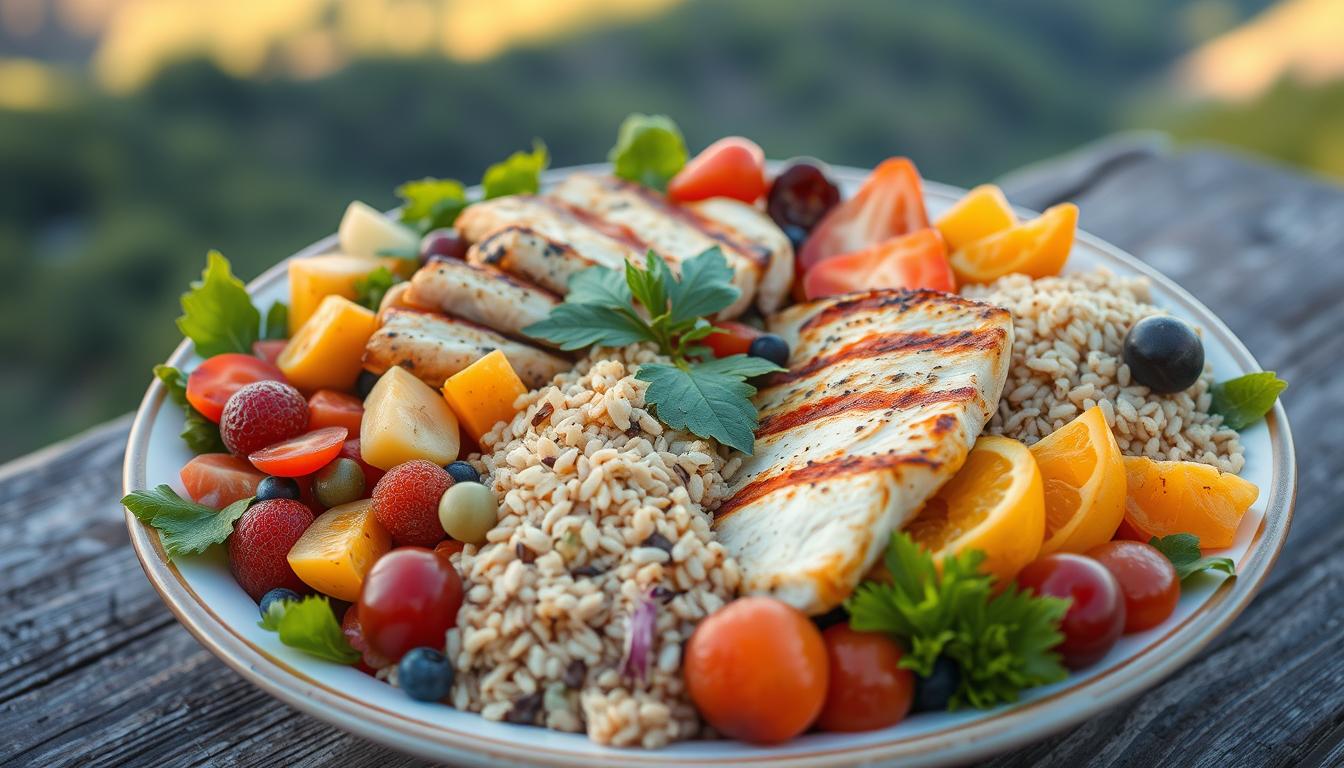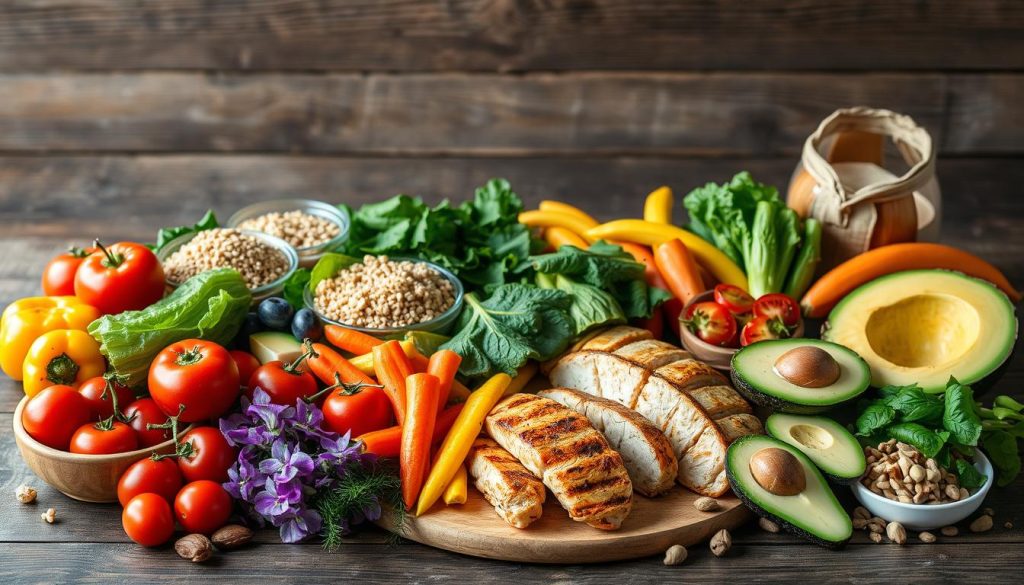
Starting a weight loss journey can be tough, but it’s doable with the right approach. This article will cover six effective strategies for losing weight. These include building sustainable habits, creating personalized diet plans, and staying active.
It’s all about making changes that last, not quick fixes. By focusing on practical, long-term strategies, you can achieve your fitness goals. Healthy weight loss is about building better habits that stick with you.

Key Takeaways
- Understand the science behind weight loss for better results.
- Focus on a balanced diet rich in macronutrients and superfoods.
- Incorporate regular physical activity into your routine.
- Maintain a positive mindset and set achievable goals.
- Track your progress to stay motivated and on course.
Understanding the Basics of Weight Loss
Losing weight can seem hard, but knowing the basics makes it easier. By learning about weight loss science, you can see how a calorie deficit and metabolic rate are key to reaching your weight goals.
The Science Behind Weight Loss
Weight loss science is all about energy balance. It’s simple: eat fewer calories than your body burns. This is crucial for creating a calorie deficit, which is vital for losing weight.
When you eat fewer calories than your body needs, it uses stored fat. This leads to weight loss.
Calories In vs. Calories Out
The idea of “calories in vs. calories out” is key to managing weight. To lose weight, you need to know how many calories you eat (calories in) and how many you burn (calories out). This balance is affected by many things, like how active you are, your diet, and your metabolic rate.
The Role of Metabolism
Metabolism is crucial for weight loss. It’s how your body turns food into energy. Things like age, gender, muscle mass, and how active you are can change your metabolic rate.
A higher metabolic rate means your body burns more calories, even when you’re not moving. This helps you lose weight more efficiently.
| Factor | Impact on Metabolism |
|---|---|
| Age | Metabolism slows down with age. |
| Gender | Men generally have a higher metabolic rate than women. |
| Muscle Mass | More muscle mass increases metabolic rate. |
| Physical Activity | Regular exercise boosts metabolic rate. |
Importance of a Balanced Diet
Eating a balanced diet is key for losing weight and staying healthy. It means getting the right mix of proteins, carbs, and fats. This ensures your body gets the fuel it needs.
Macronutrients and Their Role
Macronutrients are important for keeping your energy up and helping your body work right. Proteins help fix and grow muscles, carbs give you energy, and fats are good for hormones and cells. Knowing how to balance these can make your diet better.
Incorporating Superfoods in Your Diet
Superfoods can make your diet much better. Foods like blueberries, quinoa, and kale are full of vitamins, minerals, and antioxidants. They help you stay healthy and can help you lose weight by boosting your metabolism and giving you important nutrients.

Meal Planning Tips
Good meal planning is important for lasting success. Here are some tips for planning meals to keep your diet balanced:
- Plan Ahead: Make your meals before to avoid bad choices.
- Balance Macronutrients: Make sure each meal has proteins, carbs, and fats.
- Incorporate Superfoods: Add superfoods to your meals for more health benefits.
Exercise and Physical Activity
Starting a weight loss journey is more than just eating right. It also means doing regular *workout routines*. These *fitness activities* help you stay healthy and lose weight.

Mixing *cardio exercises* and *strength training* is key to losing weight well. Cardio like running, cycling, or swimming raises your heart rate and improves heart health. Here’s why it’s good:
- Increases calorie burn
- Improves heart health
- Elevates metabolism
*Strength training* is also crucial for building lean muscle. The more muscle you have, the more calories you burn even when resting. Add weight lifting, resistance band exercises, and body-weight workouts to your routine. Strength training benefits include:
- Enhanced muscle strength
- Better metabolic rate
- Improved bone density
Top personal trainers say mixing cardio and strength is best. Jillian Michaels suggests combining high-intensity interval training (HIIT) with resistance exercises. This combo maximizes calorie burn and muscle gain.
Here’s a quick look at how different *workout routines* stack up:
| Exercise Type | Principal Benefits |
|---|---|
| Cardio Exercises | Improves cardiovascular health, burns calories, boosts endurance |
| Strength Training | Increases muscle mass, enhances metabolic rate, strengthens bones |
Sticking to a mix of these *fitness activities* with increasing weights and rest days will boost your weight loss. The aim is to get healthier and fitter, not just lose weight.
Mindset and Motivation
Having a strong weight loss mindset is key to lasting success. The path to a healthier life is as much about the mind as the body. With the right motivation and support, you’re more likely to hit your goals and keep going.
Setting Achievable Goals
Setting goals is a crucial first step in weight loss. It’s important to aim for goals that are both achievable and realistic. Use the SMART criteria to guide you: Specific, Measurable, Attainable, Relevant, and Time-bound. For example, instead of saying “lose weight,” aim for “lose 10 pounds in three months.”
Overcoming Plateaus
Everyone will hit a plateau at some point. To get past it, you need patience and persistence. Take a closer look at your current plan and make small changes. Adding new activities or tweaking your diet can help you move forward. Remember, plateaus are a normal part of losing weight, and staying positive is crucial.
Finding Support Systems
Support networks are vital for weight loss success. Having friends, family, or professionals like nutritionists or trainers can offer the motivation and accountability you need. Online communities and local groups are also great for support and advice on common challenges.
Tracking and Analyzing Progress
Successful weight loss is not just about staying motivated. It also needs effective progress tracking and fitness tracking methods. Tools like mobile apps and fitness wearables help by giving detailed weight loss analytics. They show which strategies work and which need tweaking.
These technologies make it easy to track and celebrate small wins. Here are some popular ways to track progress:
- Mobile Apps: Apps like MyFitnessPal and Lose It! help with calorie counting and nutrient tracking. They make it easy to keep track of what you eat.
- Fitness Wearables: Devices from Fitbit and Garmin give real-time feedback. They let you see how much you’ve moved and burned calories all day.
- Smart Scales: Brands like Withings and Eufy have scales that connect to apps. They give detailed info on weight, body fat, and muscle mass.
By using these tools, you can make informed choices about diet and exercise. Heart rate, steps, and calories burned help tailor workouts and diets for better results.
Here’s a quick look at some top tracking tools and their features:
| Tool | Features |
|---|---|
| MyFitnessPal | Calorie counting, meal logging, nutrient tracking |
| Fitbit | Steps tracking, heart rate monitoring, sleep analysis |
| Withings Smart Scale | Weight measurement, body composition analysis, app synchronization |
Staying consistent with fitness tracking turns data into useful insights. It helps you stay on track with your weight loss goals. Regularly monitoring results boosts motivation and leads to lasting success.
Weight loss: 6 strategies for success
Effective weight loss needs a mix of diet, fitness, and mental strength. Here are six key strategies for successful weight management:
- Commit to a Balanced Diet: Make sure to eat the right mix of proteins, carbs, and fats. Adding superfoods like kale, quinoa, and blueberries can boost your health.
- Regular Exercise: Choose activities you like, from cardio to strength training. Sticking to a workout routine is crucial for losing weight.
- Stay Hydrated: Drinking enough water helps with digestion and keeps hunger in check. It’s a big help in your fitness journey.
- Track Your Progress: Keep an eye on your weight, diet, and workouts. Apps or journals can help you see what works and what doesn’t.
- Set Realistic Goals: Having reachable goals keeps you motivated and focused. Slow, steady progress is better than quick fixes.
- Find Support Systems: Having friends, family, or online groups can give you the support and motivation you need.
These strategies offer a roadmap for losing weight and highlight the need for a holistic approach. Tailor these tips to fit your life for lasting weight management.
| Strategy | Actionable Tips | Benefits |
|---|---|---|
| Balanced Diet | Incorporate macronutrients, add superfoods | Enhanced nutrition, improved health |
| Regular Exercise | Engage in enjoyable activities, be consistent | Increased fitness, weight loss |
| Hydration | Drink enough water daily | Better digestion, appetite control |
| Progress Tracking | Use apps or journals | Motivation, better insights |
| Realistic Goals | Set achievable targets | Long-term motivation, steady progress |
| Support Systems | Engage with friends, join communities | Accountability, encouragement |
By combining these weight loss strategies, you’re on the path to effective weight management and reaching your fitness goals.
Conclusion
Starting a weight loss journey takes commitment and patience. It’s not just about losing weight. It’s about making lasting changes for a healthier life. Understanding the science of weight loss and the role of balanced nutrition is key.
Adding regular exercise and a positive mindset is crucial. Remember, every small step counts. Use different ways to track your progress and stay motivated by your support system.
The secret to lasting weight loss is being consistent and flexible. By using the strategies shared, you can reach and keep your fitness goals. Take charge of your health, enjoy the journey, and feel empowered by living a healthy lifestyle.